You deploy an SAP environment on Azure.
You need to configure SAP NetWeaver to authenticate by using Azure Active Directory (Azure AD).
Which four actions should you perform in sequence? To answer, move the appropriate actions from the list of actions to the answer area and arrange them in the correct order.
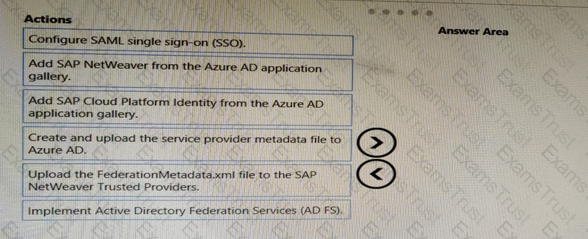
You have an existing SAP production landscape on Azure. The SAP application virtual machines have static IP addresses.
You need to replicate the virtual machines to another Azure region by using Azure Site Recovery. The source and target subnets have different address ranges.
Which three actions should you perform? Each correct answer presents part of the solution.
NOTE: Each correct selection is worth one point.
Your on-premises network is connected to an SAP HANA deployment in the East US Azure region. The deployment uses the Standard SKU of an ExpressRoute gateway.
You need to implement ExpressRoute FastPath. The solution must meet the following requirements:
• Hybrid connectivity must be maintained if a single datacenter fails in the East US region.
• Hybnd connectivity costs must be minimized.
Which ExpressRoute gateway SKU should you use?
You have an on-premises SAP landscape that contains a 20-TB IBM DB2 database. The database contains large tables that are optimized for read operations via secondary indexes.
You plan to migrate the database platform to SQL Server on Azure virtual machines.
You need to recommend a database migration approach that minimizes the time of the export stage.
What should you recommend?
You are designing the backup for an SAP database.
You have an Azure Storage account that is configured as shown in the following exhibit.
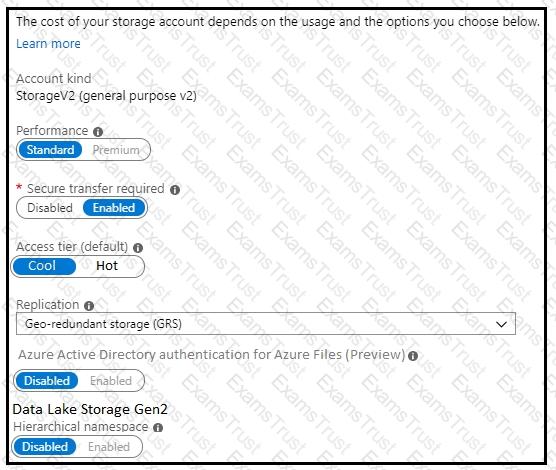
Use the drop-down menus to select the answer choice that completes each statement based on the information presented in the graphic.
NOTE: Each correct selection is worth one point.
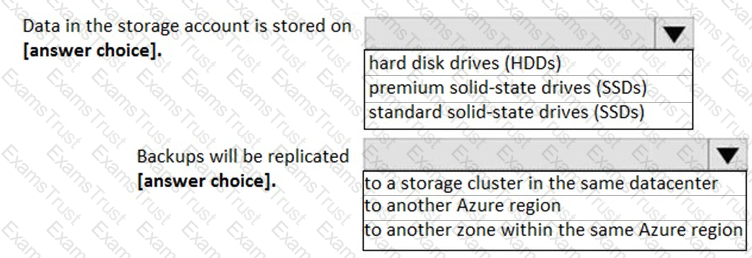
You plan to deploy an SAP environment on Azure. The SAP environment will have landscapes for production, development. and quality assurance.
You need to minimize the costs associated with running the development and quality assurance landscapes on Azure. What should you do?
You have an SAP production landscape on-premises and an SAP development landscape on Azure.
You deploy a network virtual appliance to act as a firewall between the Azure subnet and the on-premises network.
Solution: You configure route filters for Microsoft peering.
Does this meet the goal?
You are planning the Azure network infrastructure for an SAP environment.
For each of the following statements, select Yes if the statement is true. Otherwise, select No.
NOTE: Each correct selection is worth one point.
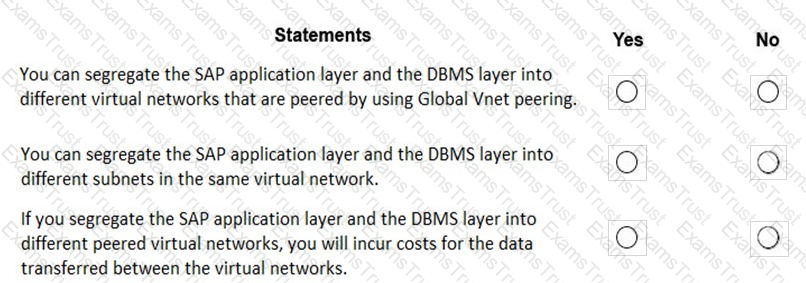
You are implementing a highly available deployment of SAP HANA on Azure virtual machines. You need to ensure that the deployment meets the following requirements:
• Supports host auto-failover
• Minimizes cost
How should you configure the highly available components of the deployment? To answer, select the appropriate options in the answer area. NOTE: Each correct selection is worth one point.
You migrate SAP ERP Central Component (SAP ECC) production and non-production landscapes to Azure.
You are licensed for SAP Landscape Management (LaMa).
You need to refresh from the production landscape to the non-production landscape.
Which four actions should you perform in sequence? To answer, move the appropriate actions from the list of actions to the answer area and arrange them in the correct order.
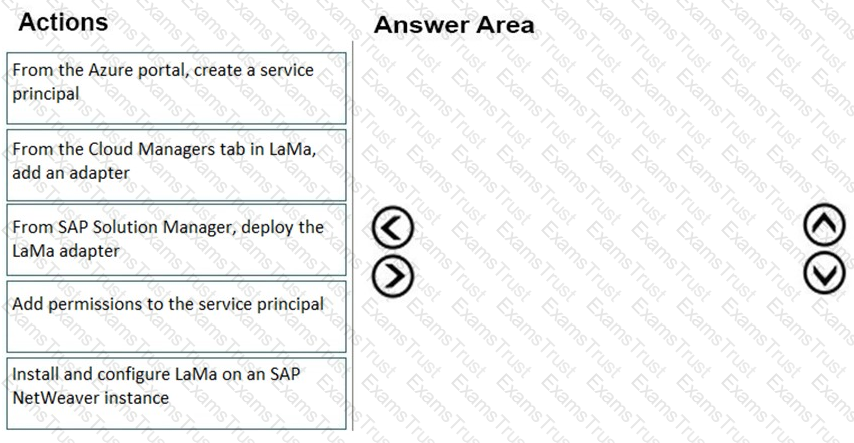
You plan to deploy SAP on Azure.
The deployment must meet the following requirements:
• Support failover to another Azure region in the event of a regional outage.
• Minimize data loss during a failover.
• Minimize costs.
Which fault tolerance technology should you choose for the SAP Web Dispatcher and the Microsoft SQL Server 2017 servers to meet the requirements? To answer, drag the appropriate technologies to The correct targets. Each technology may be used once, more than once, or not at all. You may need to drag the split bar between panes or scroll to view content.
NOTE: Each correct selection is worth one point.

You have an on-premises SAP environment hosted on VMware vSphere.
You plan to migrate the environment to Azure by using Azure Site Recovery.
You need to prepare the environment to support Azure Site Recovery.
What should you deploy first?
You plan to deploy a high availability SAP environment that will use a failover clustering solution.
You have an Azure Resource Manager template that you will use for the deployment. You have the following relevant portion of the template.
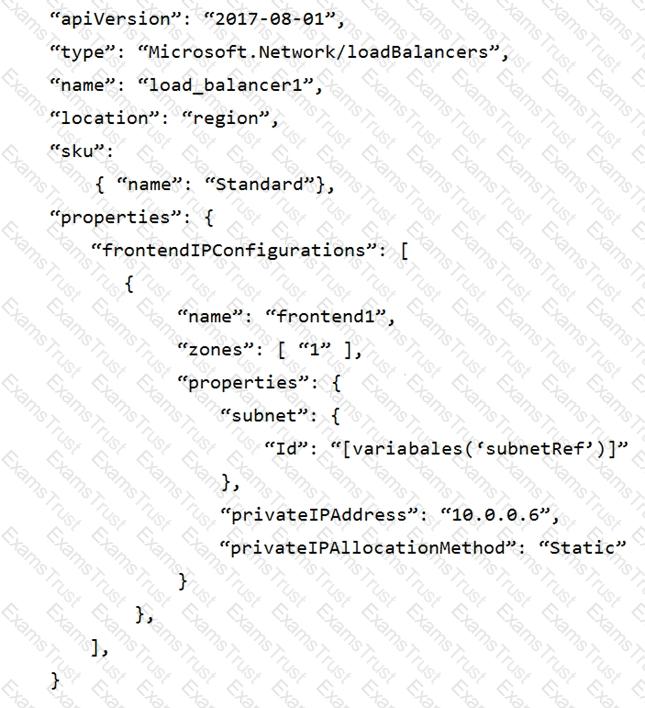
What is created by the template?
You have an SAP on Azure production landscape that contains an SAP HANA database. You create a backup policy as shown in the following exhibit.
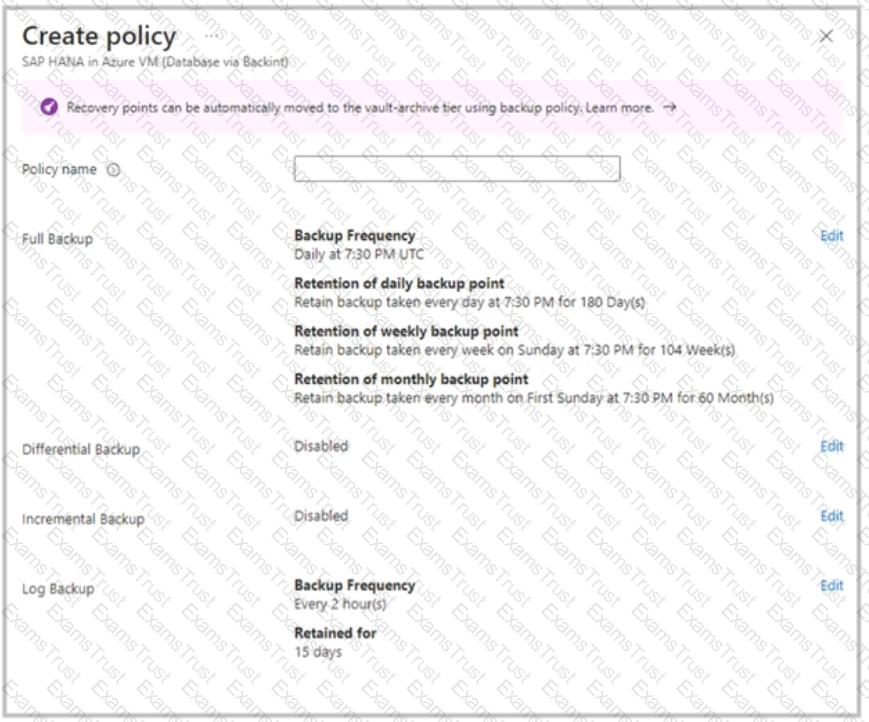
Use the drop-down menus to select the answer choice that completes each statement based on the information presented in the graphic. NOTE: Each correct selection is worth one point.

You ate planning an SAP on Azure deployment.
You need to recommend a storage access solution that meets the following requirements;
• Provides a common file share that will be accessed by virtual machines that run either Red Hat Enterprise Linux (RHEL) or Windows Server 2022.
• Ensures that each virtual machine uses its native sharing protocol to access the common file share.
Which type of storage should you include in the recommendation?
You have an Azure subscription that contains the resources shown in the following table.

You plan to deploy an SAP production landscape.
You create the following PowerShell Desired State Configuration (DSC) and publish the DSC configuration to corpsoftware.

You need to deploy the DSC configuration to VM1.
How should you compete the command? To answer, select the appropriate options in the answer area NOTE: Each correct selection is worth one point.

You have four SAP NetWeaver servers that run on Azure virtual machines deployed across two Azure Availability Zones. You plan to deploy a load balancing solution for the SAP GUI app. What should you use?
For each of the following statements, select Yes if the statement is true. Otherwise, select No. NOTE: Each correct selection is worth one point.

You have a single-instance SAP NetWeaver deployment hosted on Azure virtual machines that run Windows Server 2022.
You plan to implement Azure Monitor for SAP Solutions to monitor the application tier.
You need to ensure that Azure Monitor (or SAP Solutions can access the SAPControl web service methods on the application tier. The solution must minimize application downtime.
Which three actions should you perform in sequence? To answer, move the appropriate actions from the list of actions to the answer area and arrange them in the correct order.

You have an SAP production landscape on-premises and an SAP development landscape on Azure.
You deploy a network virtual appliance to act as a firewall between the Azure subnet and the on-premises network.
Solution: You deploy an Azure Standard Load balancer.
Does this meet the goal?
You have an SAP landscape on Azure.
You plan to deploy a new SAP application server by using an Azure Resource Manager template.
You need to ensure that all new servers are deployed with Azure Disk Encryption enabled.
How should you complete the relevant component of the template? To answer, select the appropriate options in the answer area.
NOTE: Each correct selection is worth one point.
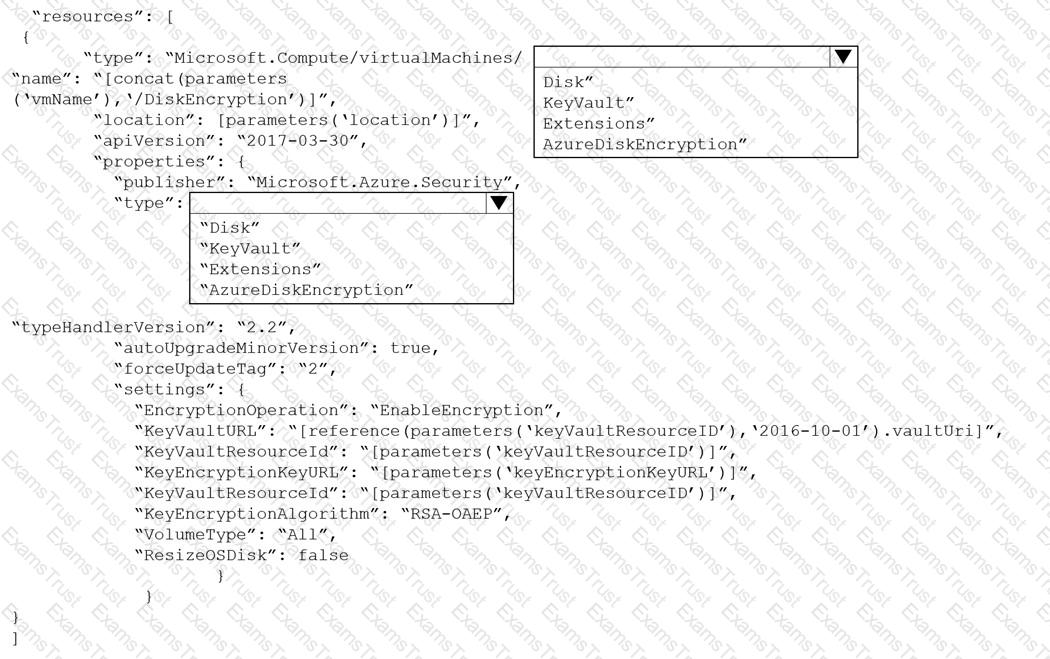
You have an Azure subscription. The subscription contains two virtual machines named SQL1 and SQL2 that host a Microsoft SQL Server 2019 Always On availability group named AOG1.
You plan to deploy an SAP NetWeaver system that will have a database tier hosted on AOG1.
You need to encrypt the Azure virtual machine disks and the SQL Server database. The solution must meet the following requirements:
• The operating system disk, data disk, and the temporary disk of the virtual machines must be encrypted.
• SQL Server encryption keys must be stored on-premises.
Which type of encryption should you use? To answer, select the appropriate options in the answer area. NOTE: Each correct selection is worth one point.

You are planning an SAP NetWeaver deployment on Azure. The database her will consist of Two Azure virtual machines that have Microsoft SQL Server 2017 installed. Each virtual machine will be deployed to a separate availability zone.
You need to perform the following:
• Minimize network latency between the virtual machines.
• Measure network latency between the virtual machines.
What should you do? To answer, select the appropriate options in the answer area.
Your on-premises network contains SAP and non-SAP applications.
You have JAVA-based SAP systems that use SPNEGO for single-sign on (SSO) authentication.
Your external portal uses multi-factor authentication (MFA) to authenticate users.
You plan to extend the on-premises authentication features to Azure and to migrate the SAP applications to Azure.
For each of the following statements, select Yes if the statement is true. Otherwise, select No.
NOTE: Each correct selection is worth one point.
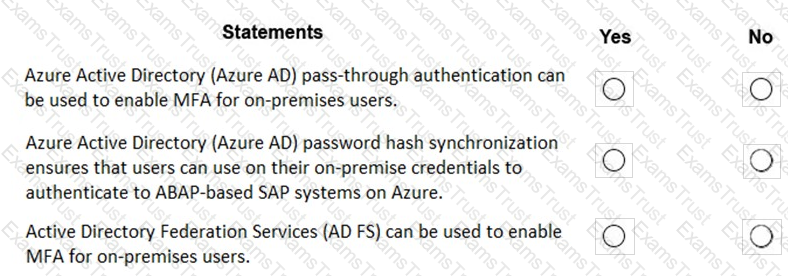
You plan to implement a highly available SAP HANA deployment by using two Azure virtual machines that run SUSE Linux Enterprise Server (SLES). You need to create an Azure Fence agent STONITH block device (SBD).
What should you do first?
What should you use to perform load testing as part of the migration plan?
You are evaluating the migration plan.
Licensing for which SAP product can be affected by changing the size of the virtual machines?
You need to recommend a solution to reduce the cost of the SAP non-production landscapes after the migration.
What should you include in the recommendation?
For each of the following statements, select Yes if the statement is true. Otherwise, select No.
NOTE: Each correct selection is worth one point.

You need to ensure that you can receive technical support to meet the technical requirements.
What should you deploy to Azure?
For each of the following statements, select Yes if the statement is true. Otherwise, select No.
NOTE: Each correct selection is worth one point.

Litware is evaluating whether to add high availability after the migration?
What should you recommend to meet the technical requirements?
You are evaluating which migration method Litware can implement based on the current environment and the business goals.
Which migration method will cause the least amount of downtime?
You need to provide the Azure administrator with the values to complete the Azure Resource Manager template.
Which values should you provide for diskCount, StorageAccountType, and domainName? To answer, select the appropriate options in the answer area.
NOTE: Each correct selection is worth one point.
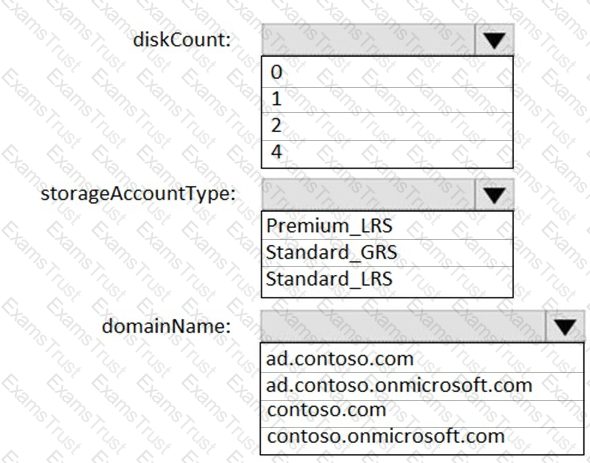
Which Azure service should you deploy for the approval process to meet the technical requirements?
Before putting the SAP environment on Azure into production, which command should you run to ensure that the virtual machine disks meet the business requirements? To answer, select the appropriate options in the answer area.
NOTE: Each correct selection is worth one point.

You are planning the Azure network infrastructure to support the disaster recovery requirements.
What is the minimum number of virtual networks required for the SAP deployed?
This question requires that you evaluate the underlined BOLD text to determine if it is correct.
You are planning for the administration of resources in Azure.
To meet the technical requirements, you must first implement Active Directory Federation Services (AD FS).
Instructions: Review the underlined text. If it makes the statement correct, select “No change is needed”. If the statement is incorrect, select the answer choice that makes the statement correct.
You are planning replication of the SAP HANA database for the disaster recovery environment in Azure.
For each of the following statements, select Yes if the statement is true. Otherwise, select No.
NOTE: Each correct selection is worth one point.
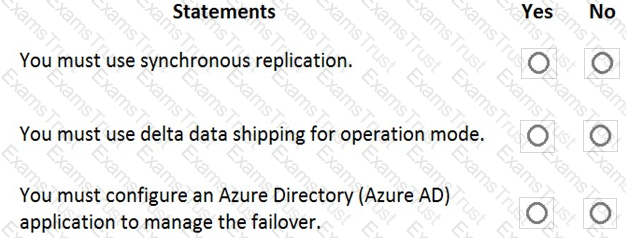
You are evaluating the proposed backup policy.
For each of the following statements, select Yes if the statement is true. otherwise, select No.
NOTE: Each correct selection is worth one point.
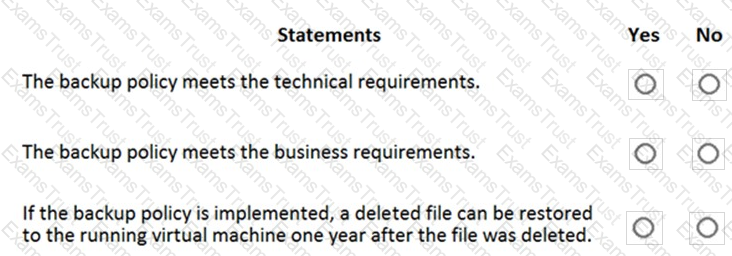
Once the migrate completes, to which size should you set the ExpressRoute circuit to the New York office to meet the business goals and technical requirements?